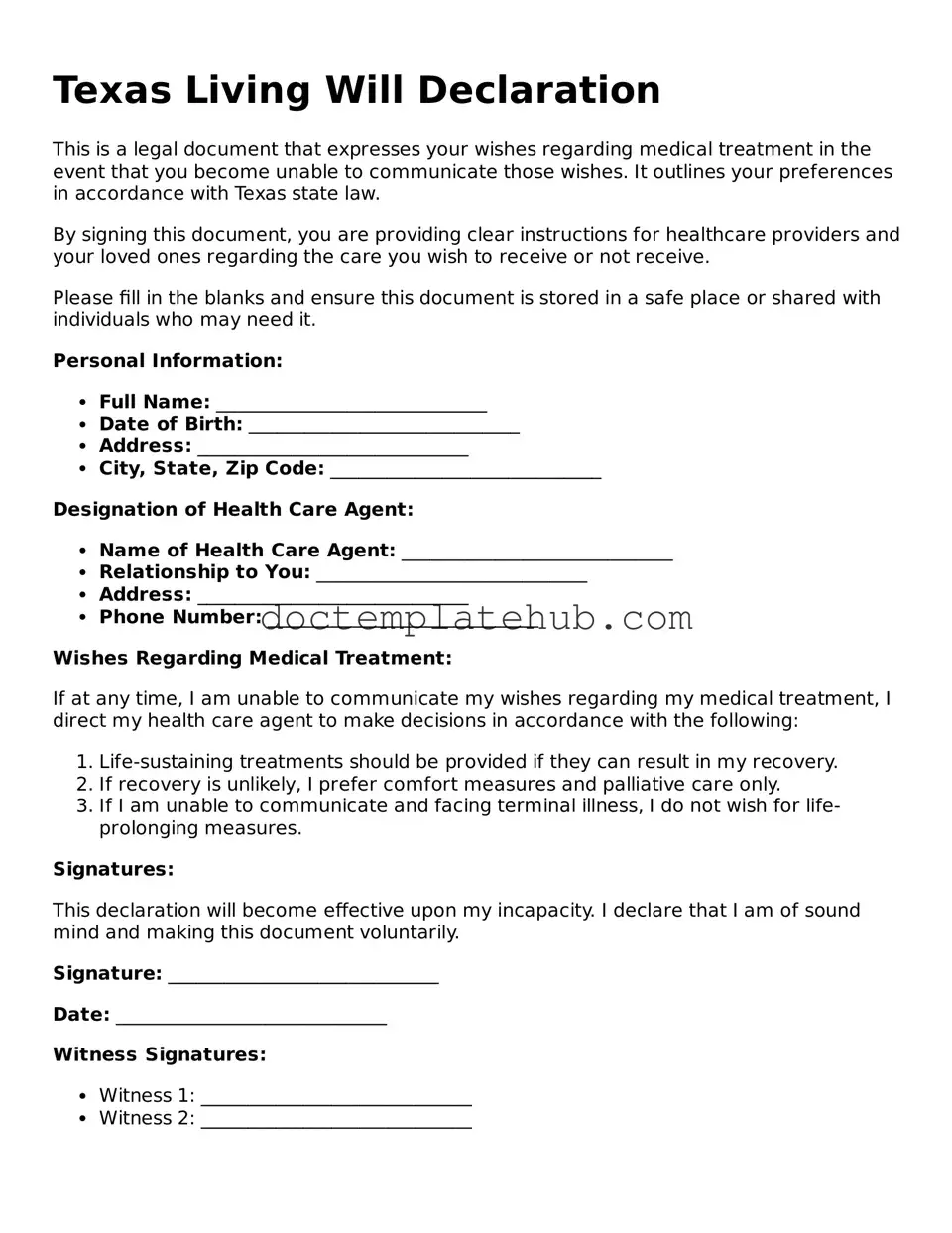The Texas Living Will form is similar to a Durable Power of Attorney for Health Care. Both documents allow individuals to express their healthcare preferences in advance. However, while a Living Will specifically outlines the types of medical treatment a person wishes to receive or refuse in certain situations, a Durable Power of Attorney for Health Care appoints someone to make healthcare decisions on behalf of the individual if they are unable to do so themselves. This means that while both serve to communicate healthcare wishes, they operate in different ways regarding decision-making authority.
Another document akin to the Texas Living Will is the Advance Directive. This term is often used interchangeably with Living Will, but it encompasses a broader range of instructions regarding medical treatment. An Advance Directive can include both a Living Will and a Durable Power of Attorney for Health Care, allowing individuals to provide detailed instructions about their healthcare preferences and designate someone to make decisions if they cannot. Therefore, the Advance Directive serves as a comprehensive tool for managing future healthcare decisions.
The Do Not Resuscitate (DNR) order is also similar to the Texas Living Will. A DNR is a specific medical order that instructs healthcare providers not to perform cardiopulmonary resuscitation (CPR) if a person's heart stops beating or if they stop breathing. While a Living Will provides broader instructions about medical treatment preferences, a DNR focuses solely on the resuscitation aspect. Both documents aim to respect a person's wishes regarding end-of-life care.
Health Care Proxy documents share similarities with the Texas Living Will as well. A Health Care Proxy allows an individual to appoint someone to make healthcare decisions on their behalf. While the Living Will specifies what treatments a person does or does not want, the Health Care Proxy empowers the designated individual to make decisions based on the person’s values and preferences. This relationship creates a dynamic where the proxy can adapt to unforeseen circumstances, ensuring that the individual’s wishes are honored.
Understanding how to properly fill out a Boat Bill of Sale form can significantly ease the ownership transfer process for both parties involved. Ensure you have all necessary details before proceeding by consulting a reliable guide to completing a Boat Bill of Sale.
Another related document is the Physician Orders for Life-Sustaining Treatment (POLST). This form is designed for individuals with serious illnesses and outlines specific medical orders regarding life-sustaining treatments. Like a Living Will, the POLST communicates a person's wishes about medical interventions. However, the POLST is a more actionable document that healthcare providers can follow immediately, while a Living Will may require interpretation and discussion among family and medical staff.
The Five Wishes document also bears resemblance to the Texas Living Will. This document goes beyond medical preferences by addressing personal, emotional, and spiritual wishes regarding end-of-life care. It allows individuals to express their desires about how they want to be treated, who they want to make decisions for them, and what they want their loved ones to know. While a Living Will primarily focuses on medical treatment, Five Wishes provides a more holistic approach to end-of-life planning.
The Advance Care Plan is another document that aligns closely with the Texas Living Will. This plan outlines an individual's healthcare preferences and can include various components, such as a Living Will and a Durable Power of Attorney. It serves as a comprehensive guide for family members and healthcare providers, ensuring that the individual's wishes are clearly understood and respected. The Advance Care Plan encourages discussions about healthcare decisions, making it a valuable tool for proactive planning.
Lastly, the Medical Directive can be compared to the Texas Living Will. This document provides specific instructions regarding medical treatment preferences in situations where an individual cannot communicate their wishes. Similar to a Living Will, the Medical Directive focuses on the types of interventions a person desires or wishes to avoid. The key difference lies in the terminology and specific requirements, which may vary by state, but both serve the essential purpose of ensuring that a person's healthcare wishes are honored.
